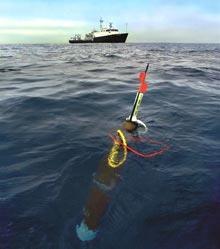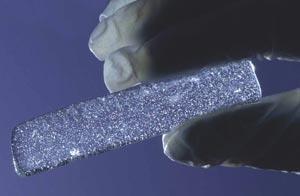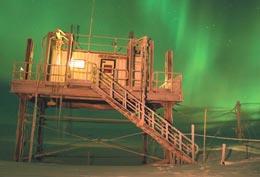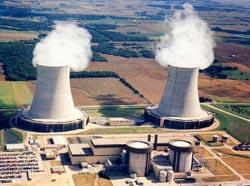High pressures, cold temperatures and inaccessible samples all make analytical work challenging. Katie Gibb explores the techniques used by chemists working in hostile conditions
High pressures, cold temperatures and inaccessible samples all make analytical work challenging. Katie Gibb explores the techniques used by chemists working in hostile conditions
Obtaining analytical data has become routine for chemists. Developments in the past few decades have led to accurate and sensitive instruments that deliver time and time again. But there are still some areas this technology simply cannot reach. Imagine an environment so severe that scientists can’t survive, where conventional equipment won’t work, and collecting simple data is more than just an everyday task. For scientists like Jim Bishop, this challenge is just the beginning.

As geological staff scientist at the Lawrence Berkeley National Laboratory, US, Bishop is one of many scientists whose research takes him to extreme places. He is currently researching the ocean’s biological carbon pump. According to Bishop, although the pump is thought to be integral to the ocean’s carbon cycle and play a strong role in determining atmospheric carbon dioxide levels, little is known about its function because it is extremely difficult to monitor.
Bishop and his team continually stretch modern technology to its limits to get the data they need. ’The major challenge is simply to be there to follow the rapid processes,’ he explains. The longest a ship can remain functional at sea in one location is several weeks, making safety and cost strong limiting factors. High seas and winds, sub-zero and sometimes ice-covered waters are not uncommon for some areas of the ocean. ’I’ve spent about two years of my life at sea on ships. All work stops in bad weather and ships generally avoid working during winter conditions due to these limitations,’ he says. ’I can’t think of anything more extreme than.the high seas and winds of the roaring 50s of the Southern Ocean.’
Bishop is working to overcome observational gaps with devices called carbon explorers; low-cost long-lived robotic ocean-profilers. ’In simple terms we are able to use these devices to be there year-round and conduct high frequency observations of the variations of particulate organic carbon - mainly plankton biomass - to kilometre depths in the ocean,’ he says.
Carbon explorers, developed through collaboration between Scripps Institution of Oceanography and Wet Labs, use bidirectional, fast satellite communications. They have temperature and salinity sensors that are augmented to particulate organic carbon. Other sensors for the system are currently nearing completion.
The robots are fitted with scattering sensors and a transmissometer, a device used to measure transmission of light through a medium, to provide details about the dynamics of particulate organic carbon. Other sensors, capable of surface to bottom surveys of the ocean, allow distributions of particulates to be measured with much higher precision than is possible using ship-collected samples.
As telemetric systems they provide automatic data transmission and measurement from remote sources by radio or other means, allowing them to be used in the ocean for extended periods. They can also endure huge pressure variations in highly corrosive and conductive seawater. ’They get tossed in 10m seas and must survive,’ adds Bishop.
New insights
This technology has other benefits. ’Our carbon explorers have so far yielded eight instrument-years of high frequency observations of the variability of particulate organic carbon in just four years, exceeding my ship sea time experience over 25 years by a factor of five,’ says Bishop. He explains that the effects of marine biofouling - living organisms growing on the equipment - are minor for carbon explorers because of the way they operate. ’When not profiling, they sleep at great depth away from the biologically and biofouling active euphotic surface layer of the ocean; they surface just long enough to transmit their data.’
At approximately $25,000 (?14,000) each, these robots are not cheap, but of the dozen carbon explorers that have been deployed to date in some of the world’s more remote and extreme ocean environments, every one has yielded new insights.
The first two explorers were released in the waters of the subarctic North Pacific to record the biological response to iron deposition during the passage of an intense storm laden with Gobi desert dust in 2001. ’As predicted, phytoplankton biomass increased over two weeks in response to deposition of iron from the storm,’ says Bishop. What was not expected, he explains, was that the effect of dust deposited iron only lasted for several weeks. ’Research ships have been journeying to the same location for decades, multiple times per year, and had not observed the effects from a single dust storm.’
Four explorers, deployed in 2002 north and south of the Antarctic polar front as part of the Southern Ocean iron experiment, again revealed effects that couldn’t be detected by ship. One pair at 55S, 172W was recording data inside and outside iron amended waters. They documented unexpectedly strong biological growth and sedimentation in response to the added iron. However, a much weaker response was found for iron added at 66S, 172W. It had been previously shown by shipboard data that the low silicate levels in the Southern Ocean limit biological growth, but the data gathered by the explorer overturned this hypothesis.
One explorer then continued recording data for another 17 months, surviving two Antarctic winters in the ice edge zone to provide the first ever observations of what happens in Antarctic waters when the midday sun is absent.
Following the success of the current carbon explorers, Bishop and his team aim to develop a new global carbon observing system enhanced by low cost carbon sensor carrying devices. He believes this could provide a real time measure of the ocean sources and sinks of atmospheric carbon dioxide, and provide a predictive basis for trajectories of the ocean living and carbon cycles in a changing world.
The ocean isn’t the only extreme environment that interests scientists, as Regine R?thlisberger at the British Antarctic Survey (BAS) explains. ’I’m mainly concerned with the extreme cold environments on earth,’ she says.
R?thlisberger is part of a team working on an initiative - climate and chemistry: forcings, feedbacks and phasings in the Earth system (Cache) - that aims to interpret ice core data and reconstruct the climate of the past million years, covering glacial and interglacial cycles. Ice cores, she explains, could hold the answers to the earth’s fast climatic changes over the past million years. Subtle changes in the chemical depositions in ice over time reflect changes in temperature, wind speed, precipitation levels and transport.
’We need to understand what actually drives the major [climate] changes, and we know from these ice cores that there have been very fast transitions in the climate which are associated with the breakdown and restart of ocean circulation,’ she says. It is important to know the role of carbon dioxide and other greenhouse gases in temperature and ocean circulation change.
Severe conditions
With specialised survival gear, chosen by in-house experts, R?thlisberger’s team faced the bleak and severe conditions in Antarctica to collect the ice core samples. ’On top of ice sheets, hundreds and hundreds of kilometres from the coast, there are no animals like birds or penguins or polar bears, it’s just scientists and their camps,’ she says. Resources such as power and space are restricted in such remote regions. ’Normally the field seasons are quite short so you have less time to set things up. You are also under high pressure to deliver within in a set amount of time and if something breaks down you have to invent a substitute.’

The instruments were designed by in-house engineers to be light, mobile, and able to cope with the extreme cold; it is often as low as minus 20?C.
Ice cores, about 10cm in diameter and three metres long, were obtained using modified ice core drills and then transported back to BAS in the UK for analysis. Having completed the drilling, R?thlisberger is now analysing major ion chemistry of the melt water from the cores for compounds such as sodium, calcium chloride and nitrate, as well as dissolved gases such as formaldehyde and hydrogen peroxide.
The outer layer of the core is removed to avoid spurious results from external contamination before the ice is melted and tested with analytical instruments. ’What we are analysing is often quite close to detection limits so you actually have to push the system quite far,’ R?thlisberger explains. She commonly uses techniques such as spectrophotometry, spectrometry and ion chromatography.
’Most of the ions are selected because they have different sources that contribute to them. For example, in Antarctica calcium is a proxy for continental dust input, and the source is presumably from the southern part of South America,’ she says. ’By variation in our dust record we can get a grip on how atmospheric transport and the climate in the source region changed over time.’ She is also interested in sodium and chloride, which typically originate from the sea ice surface and give an indication of the sea ice extent in the past; sulfur, which is mainly related to biogenic activities; and ammonium, which is also of biological origin.
Past climates
There is a wealth of information to be gained from studies in Antarctica, and not just from the ice. Rhian Salmon, a tropospheric chemist at BAS, has been involved in a year-round campaign measuring and analysing trace gas concentrations at Halley station, coastal Antarctica. The project - chemistry of the Antarctic boundary layer and the interface with snow (Chablis) - aims to give a better understanding of the chemical and physical processes happening at the snow/air boundary. ’This is critical for further understanding of ice core data and therefore past climates,’ explains Salmon. ’It should also shed some light on poorly understood processes happening in all snow-covered areas, as well as in clouds containing ice particles. For many of the species we were monitoring, this is the first time they have been measured...during the Antarctic winter. All data is therefore new and exciting.’

Unlike the ice core initiative, Salmon’s work is mainly out in the field. ’To carry out this research, my colleague and I had to spend 18 months living on a moving ice shelf, inaccessible from the outside world, at BAS’s most remote research station. Our lab was situated 1km upwind of the main base, to avoid measuring local contamination, so we had quite a long commute by ski or foot every day. That’s a pretty extreme environment!’
Salmon used a variety of analytical techniques during her research, including optical absorption spectroscopy, fluorescence spectroscopy, chemiluminescence, gas and liquid chromatography, and liquid colourimetric and fluorimetic methods. ’All our instruments were cutting edge, state-of-the-art, high sensitivity machines by nature of the fact that the Antarctic atmosphere is very clean and we were measuring concentrations far lower than anywhere else in the world,’ she says. Most of the technology they use is custom-built in-house at BAS or at collaborating universities, and physically adapted to function effectively in such an extreme environment.
Even though many of the challenges Salmon and her colleagues face are related to instrument maintenance, she says that the biggest test is probably the weather. ’Taking snow pit samples in June in Antarctica is no easy task,’ she explains. ’It’s mainly about maintaining stamina and enthusiasm.’
’We had to mount a mirror on a mast 4km away from the lab to carry out some absorption measurements. For this to be effective, we had to run a 5km long electrical cable to the chosen site, build a mast that would survive the winter, and mount and fit the reflector with heaters and fans to prevent ice from crystallising on the surface and interfering with the light beam.’
Although the Chablis campaign has now finished, a new project to take a chemical-ionisation mass spectrometer out to Halley station is planned for 2006 to 2007.
Radioactive challenges
Philip Goodall, technical lead (analytical chemistry) in materials and products capability at Nexia Solutions, is involved in a very different type of environment but one that is equally harsh.

Goodall is currently measuring chemical and physical properties of materials throughout the nuclear fuel cycle. ’Our work has the overall aim of any industrial research laboratory - how to run the business better, faster, cleaner, cheaper and more safely,’ he says. ’This ranges from an understanding of the fundamental chemistry underlying the behaviour of radioactive materials to developing methods for routine process control.’
Although on the surface of it this may sound simple, monitoring radioactive samples produced during the nuclear fuel cycle creates several difficult challenges. Only limited amounts of samples are used, making it crucial to get it right first time. ’We may have only one shot at the analysis,’ Goodall says. Material durability is also an important factor, especially because of conflicts between chemical and radiation tolerance. Microprocessors are not radiation tolerant and even simple laboratory equipment is now usually microprocessor controlled.
The samples under study contain high levels of actinides and/or fission products and often behave differently in analytical processes as a result of radiation effects. ’Methods that are developed with non-active or low-active simulants can behave quite differently on the real sample,’ Goodall explains. The materials are also chemically highly complex, typically corrosive and are usually fairly inaccessible. Samples may be housed in vessels with steel walls up to 10cm thick and may be encased in metres of concrete.
’The availability of a sample is always a problem - how do you take the sample and is it representative?’ asks Goodall. ’For these reasons, we have programmes looking at remote analysis like laser induced breakdown spectroscopy. The most interesting aspect of the work.is the challenge of combining measurement rigour with the technical difficulty in handling or even accessing the sample,’ he adds.
Necessary protection
To work within the constraints enforced by the engineered enclosures that are necessary for radiation protection, analysis is often restricted though fumehoods and gloveboxes or heavily shielded hot cells equipped with remote handling. To minimise these problems, a team of engineers strives to design and build instruments able to perform measurements in a highly shielded facility.
Common modifications include isolating and shielding electronics and optical components from the immediate vicinity of the sample, engineered enclosures of the parts of an instrument in contact with the sample, and remote sampling techniques such as laser ablation and remote analysis.
One such example is a specialised visual system that was created to determine the crystallisation point of highly active liquors. ’The design philosophy was to make the components in close contact with the sample relatively disposable, for example using aluminium construction rather than stainless steel,’ says Goodall. This had the benefit of keeping the weight of the unit low so that the remote manipulators could easily lift it. A camera system was placed outside the cell for sample viewing through a dense glass window, approximately 1.5m thick. The sample was contained within a standard quartz cuvette mounted in a heating/cooling/stirring unit, the control systems for which were outside the cell. Video images were processed and pixel data extracted to show the formation and dissolution of crystals as the sample was heated and cooled.
Goodall uses numerous analytical techniques, such as atomic spectroscopy, radiometrics and advanced separations for radiochemistry, to probe material properties, each method having been modified to withstand radiation. ’Rapid, select and robust separations are required. We have used extraction chromatography materials extensively for this work and have developed single column methods for the determination of actinides in highly active liquors for materials accountancy, trace uranium in concentrated plutonium nitrate solutions, impurities in actinide products and most recently zirconium in concentrated plutonium nitrate solutions.’
Goodall’s next step is developing rapid screening techniques to meet the challenges of decommissioning obsolete nuclear plants.
Like Goodall, science still has a lot to gain from studying and working in extreme environments. Someday technology may be sufficiently advanced to solve today’s problems, but as R?thlisberger says, ’the longer you work in it, the more questions you still have to answer.’
Further Reading
J K B Bishop et al, Science, 2002, 298, 8171 J K B Bishop et al, Science, 2004, 304, 417 See the Scripps Institution of Oceanography website See the British Antarctic Survey website
Companies
- SubChem Systems, Rhode Island, US, supplies specialised submersible chemical analysers for nutrients, trace metals and other chemicals; environmental consulting services; and technical support for water quality monitoring projects in fresh, estuarine, coastal and oceanic waters.
- Nexia Solutions, is part of the BNFL Group and became a wholly owned subsidiary in April 2005. It provides technology services and solutions across the nuclear fuel cycle. The company’s Sellafield site has the UK’s only facilities capable of carrying out research and development on highly active nuclear material.
- WET Labs, based in Oregon, US, develops and manufactures underwater instrumentation to detect chemical, biological and geological parameters and processes of oceans, lakes and streams. The company’s underwater sensors include fluorometers, transmissometers, scattering sensors, and spectrophotometers.
- Mechanical Solutions is based in New Jersey, US. The company solves engineering problems during the equipment design stage, or once it is installed.
- Griffin Analytical Technologies is based in Indiana, US. The company makes rugged, miniature mass spectrometers that provide fast, definitive, laboratory-calibre chemical detection and analysis in the field.
- Applied Microsystems, based in British Columbia, Canada, manufactures sensors and systems for in-situ, real-time detection and measurement in water, including the first underwater mass spectrometer. The company also specialises in designing instruments for harsh environments.
- Through its companies Bruker BioSpin, Bruker Optics, Bruker Daltonics and Bruker AXS, Bruker provides analytical equipment for a wide range of life science, biotechnical, and process analytical applications.






No comments yet